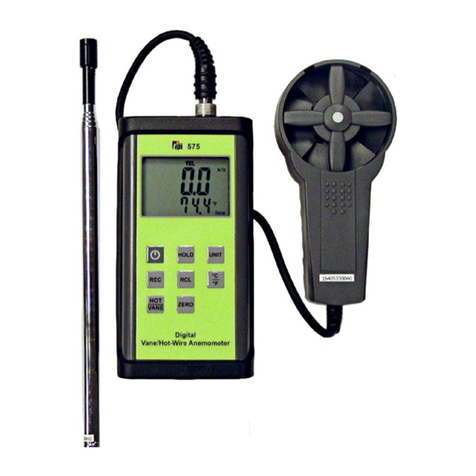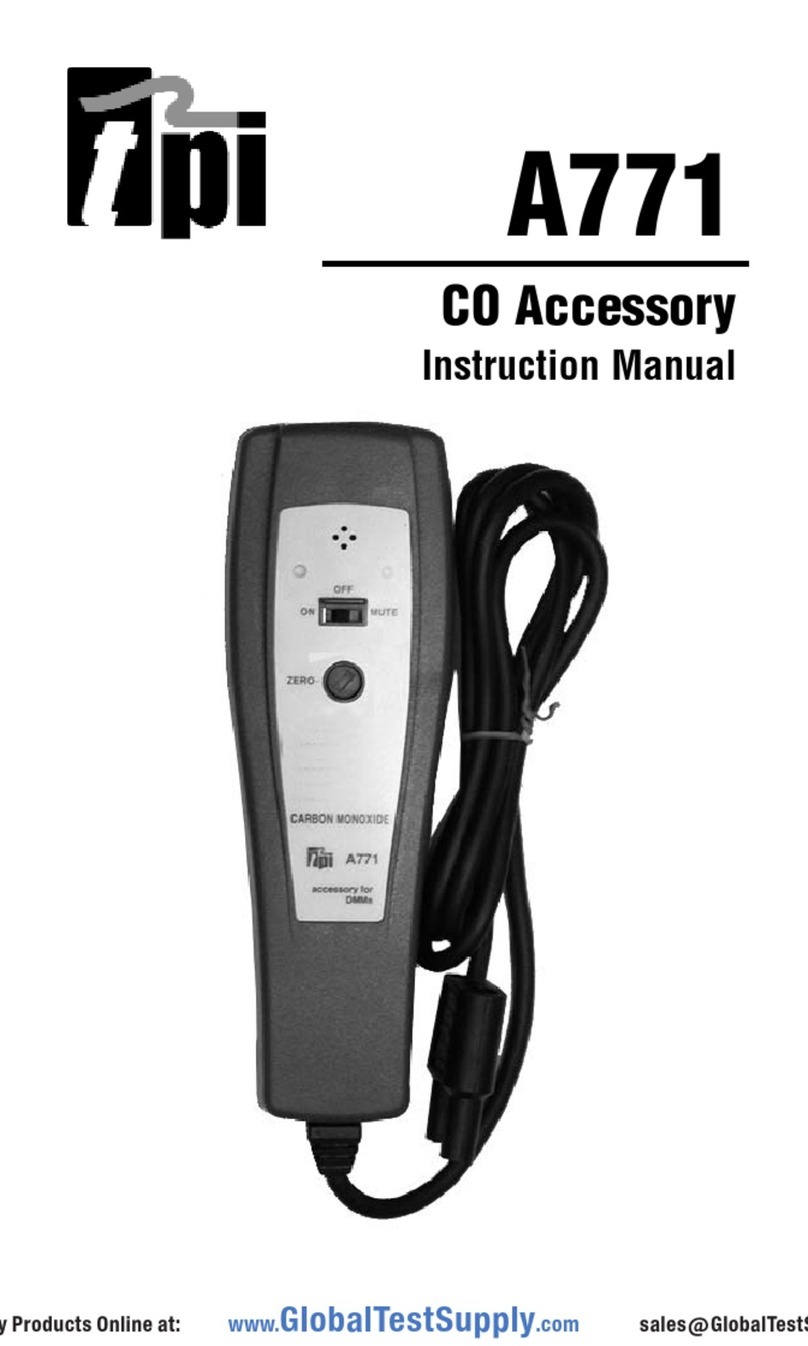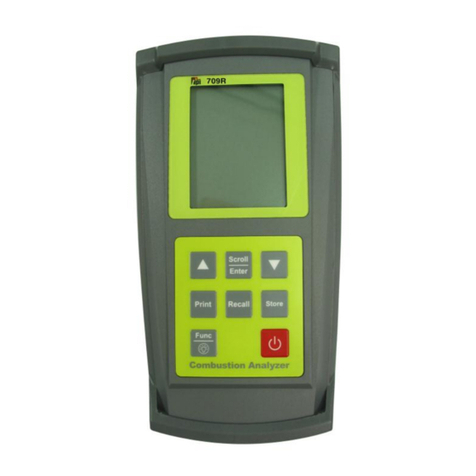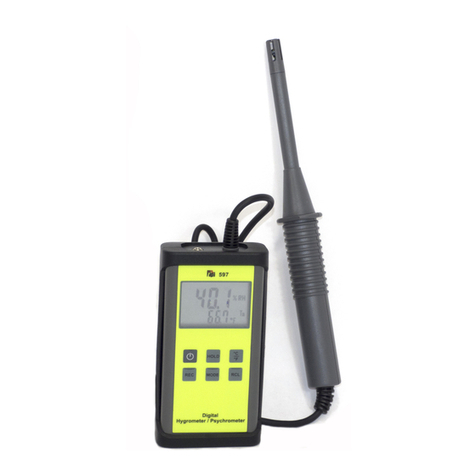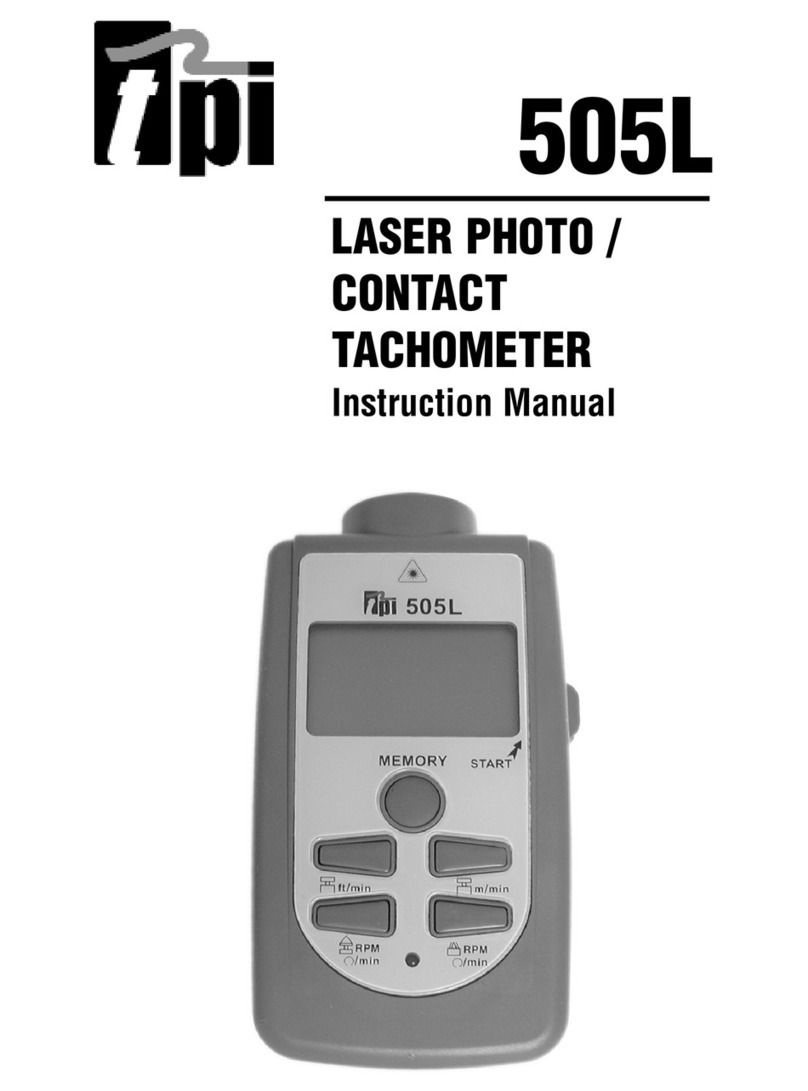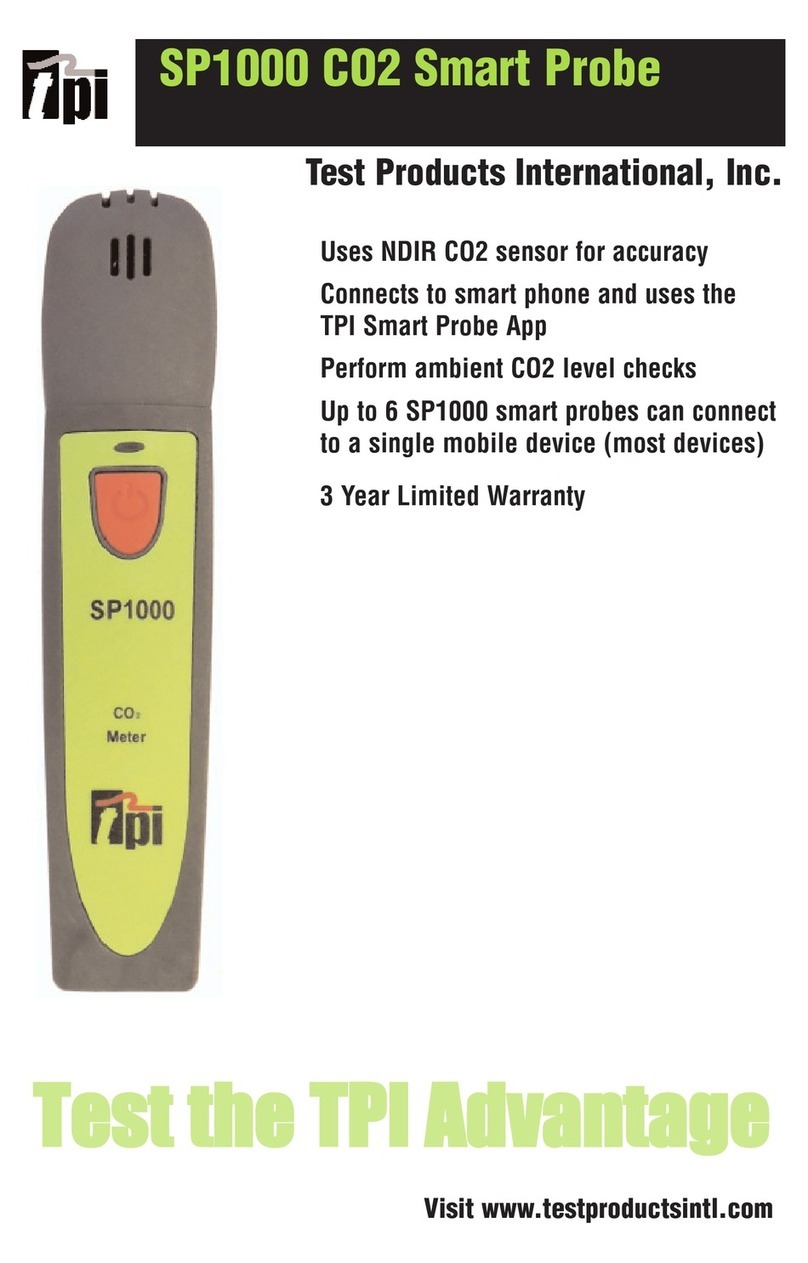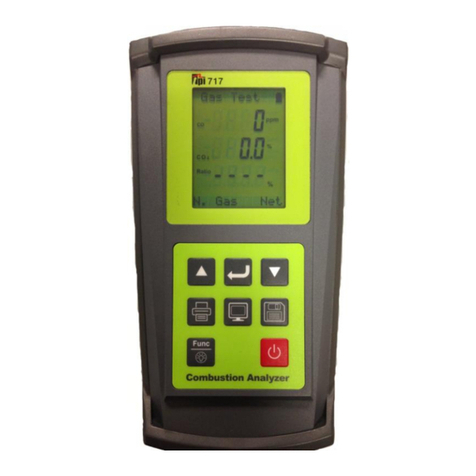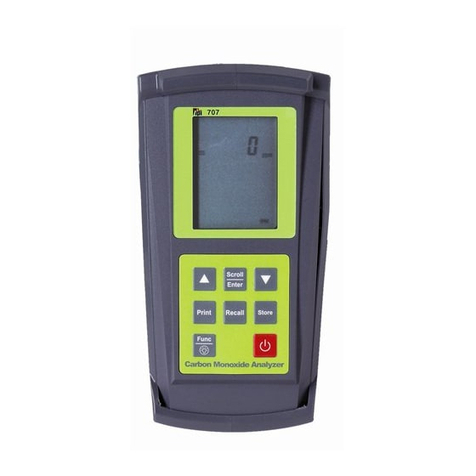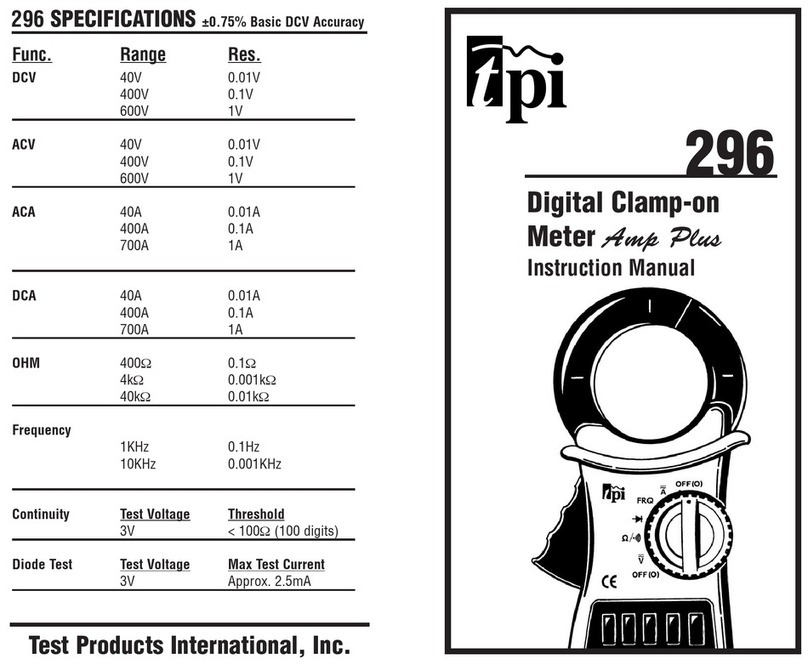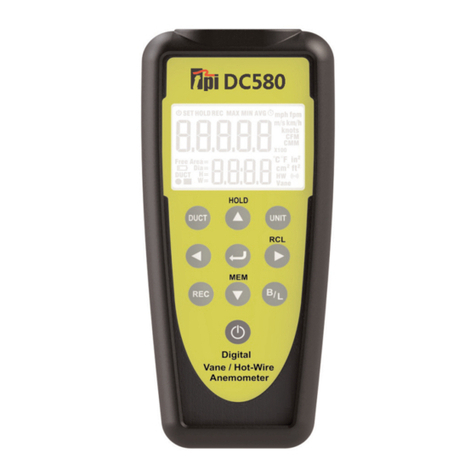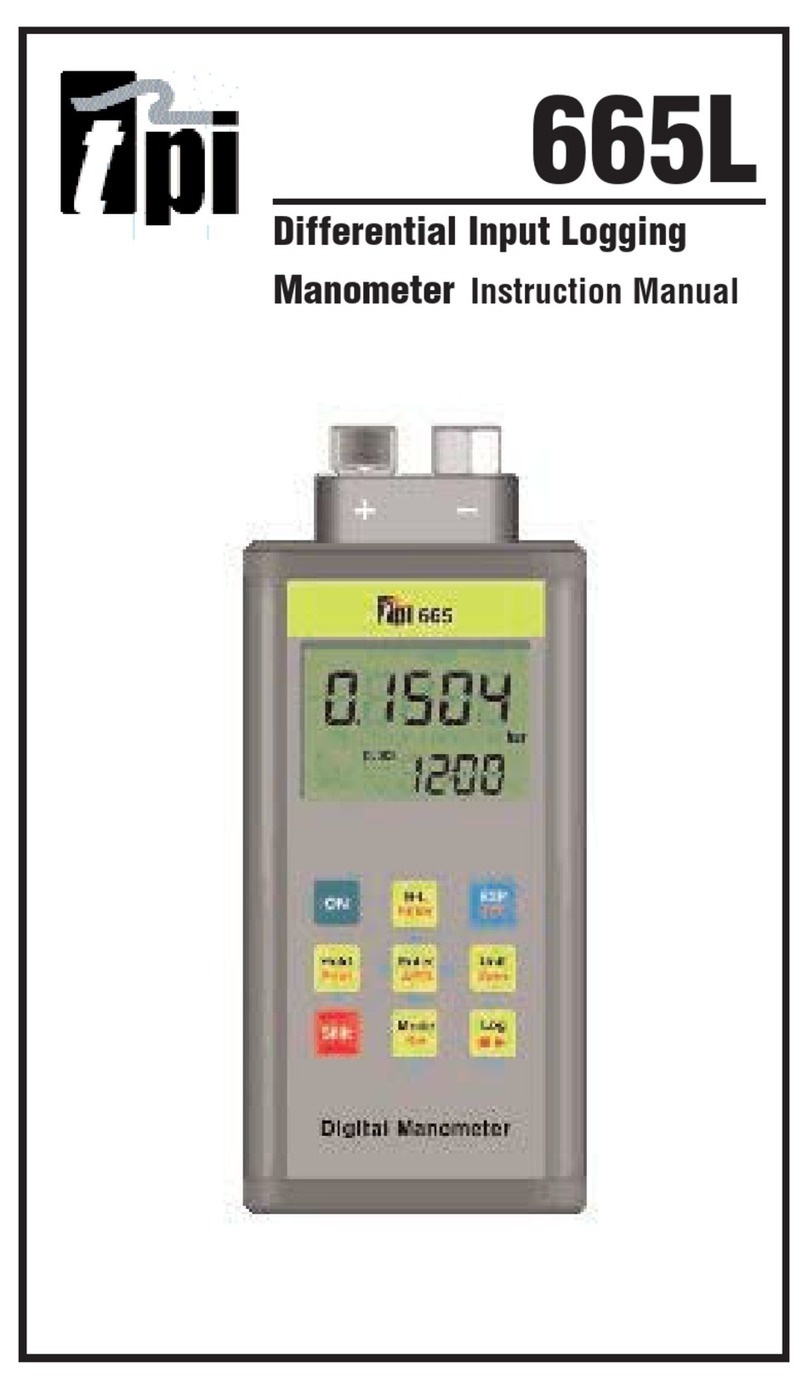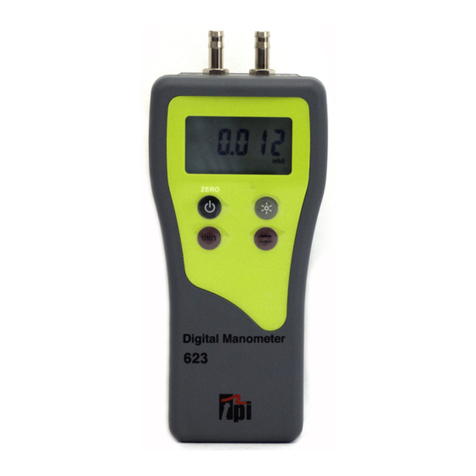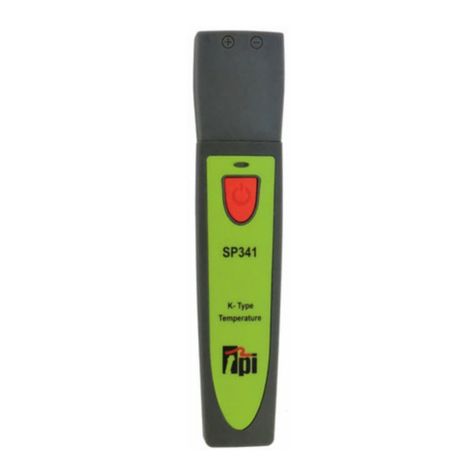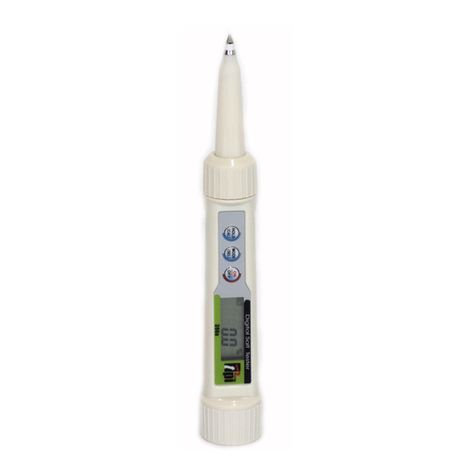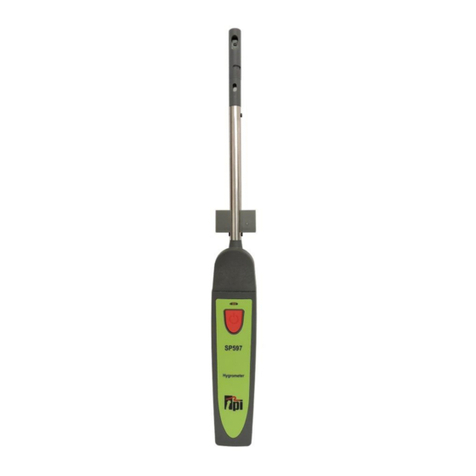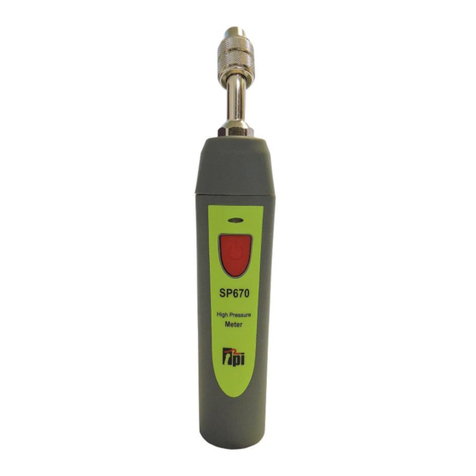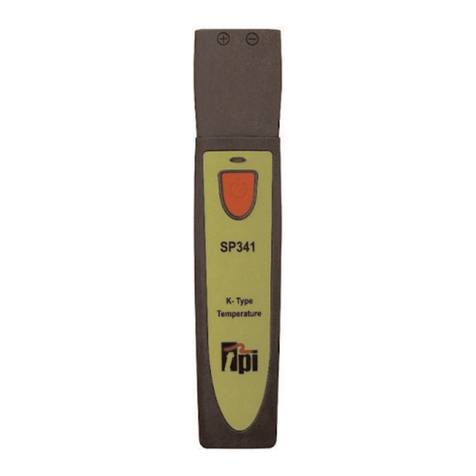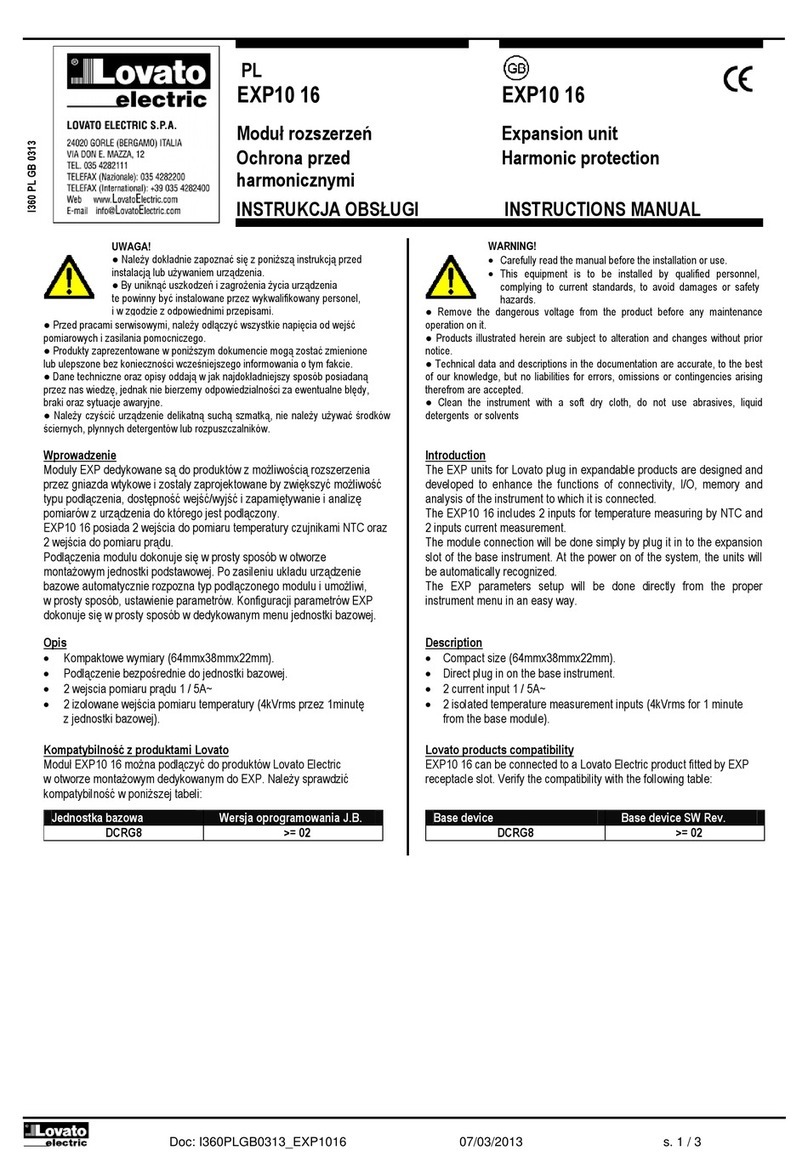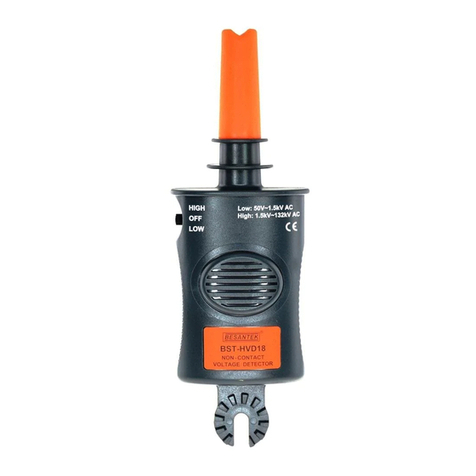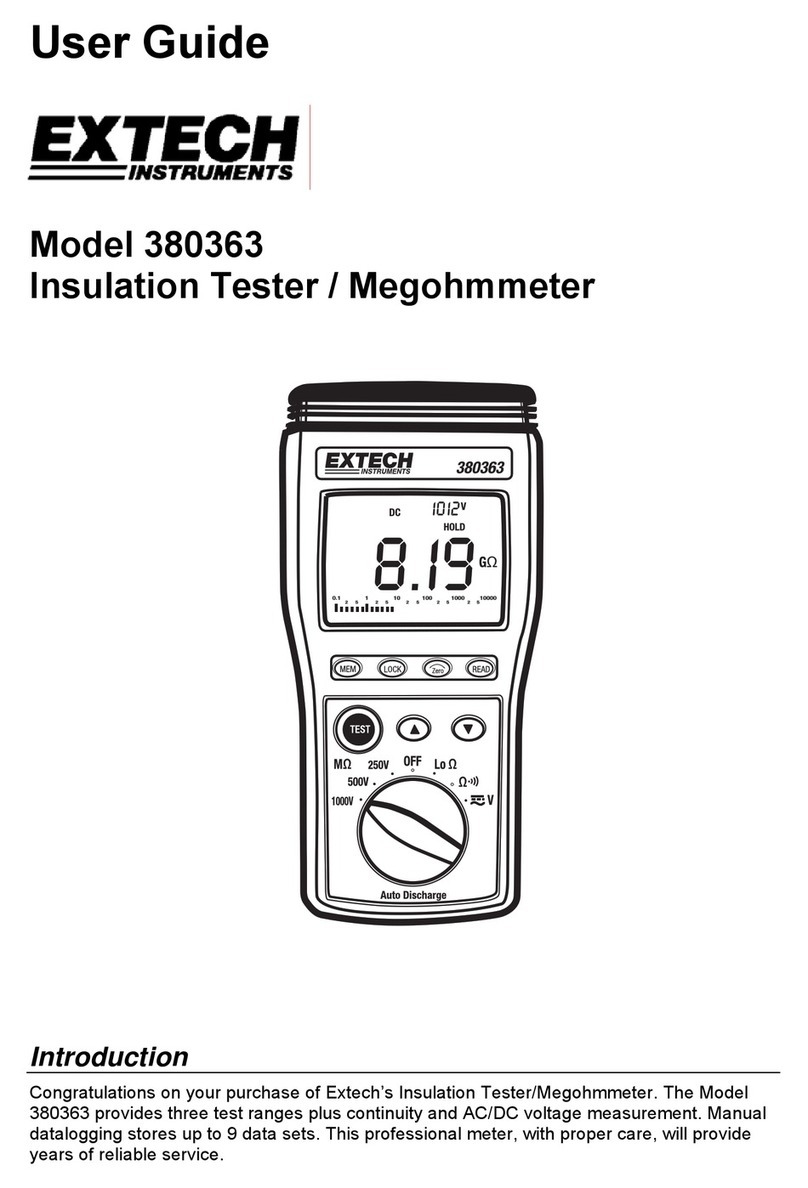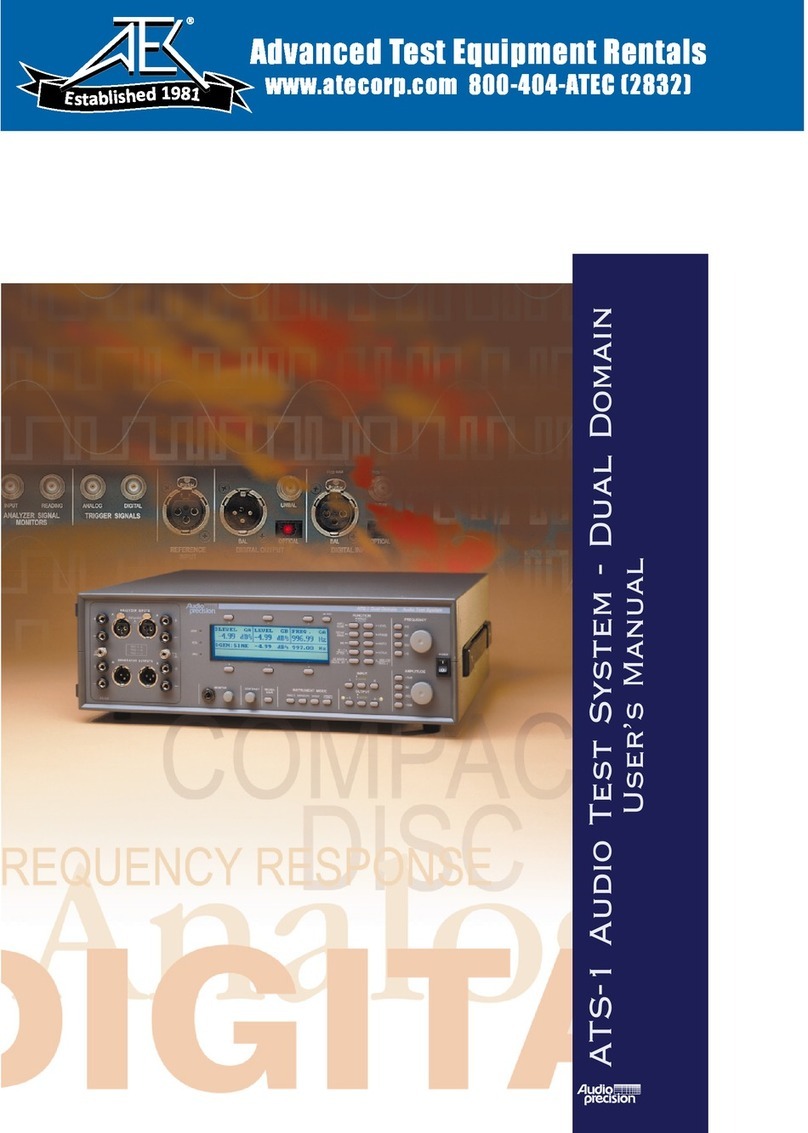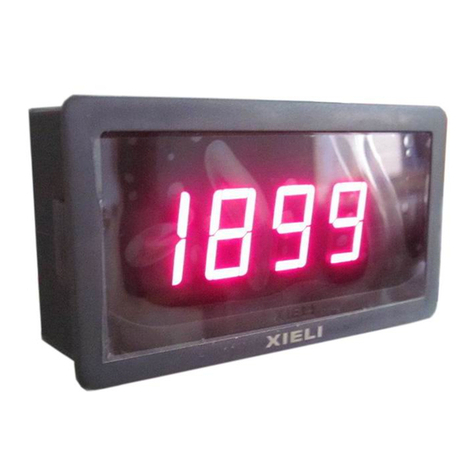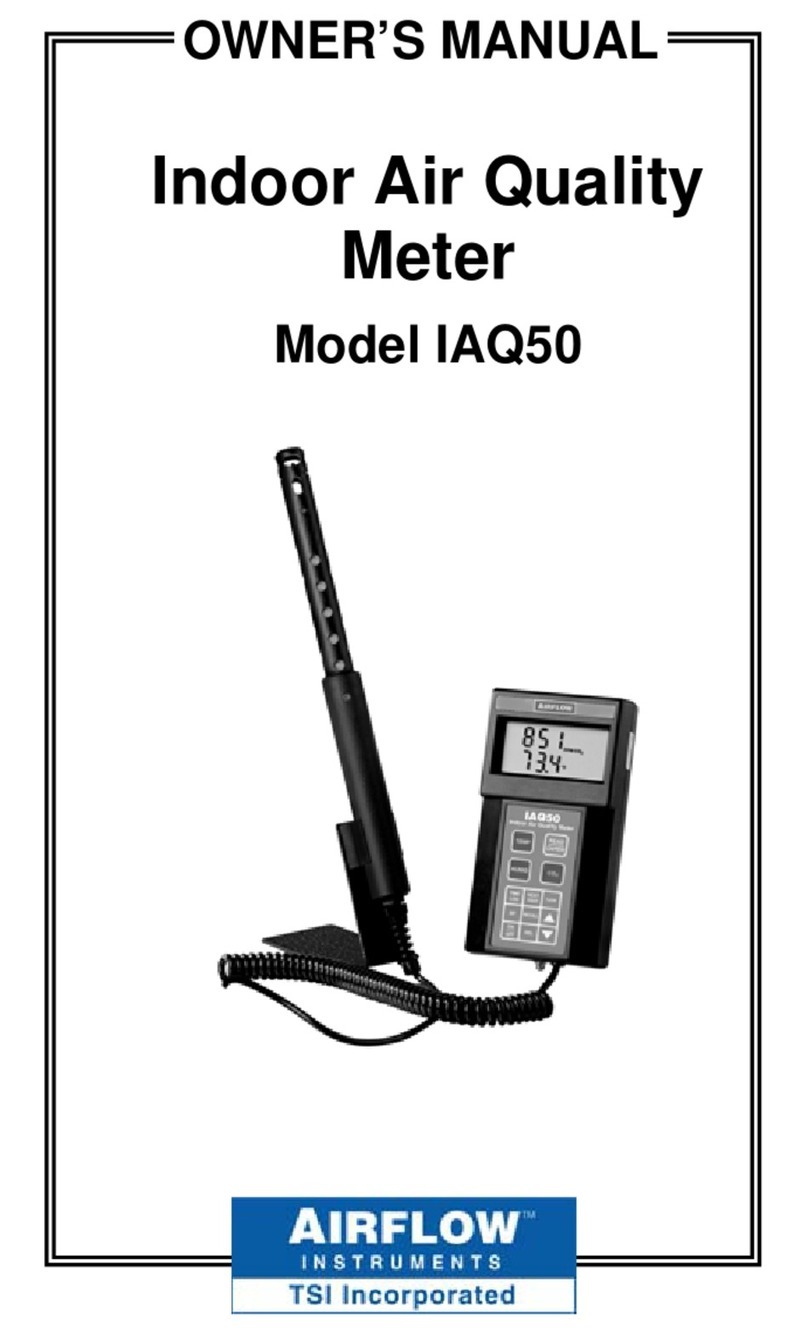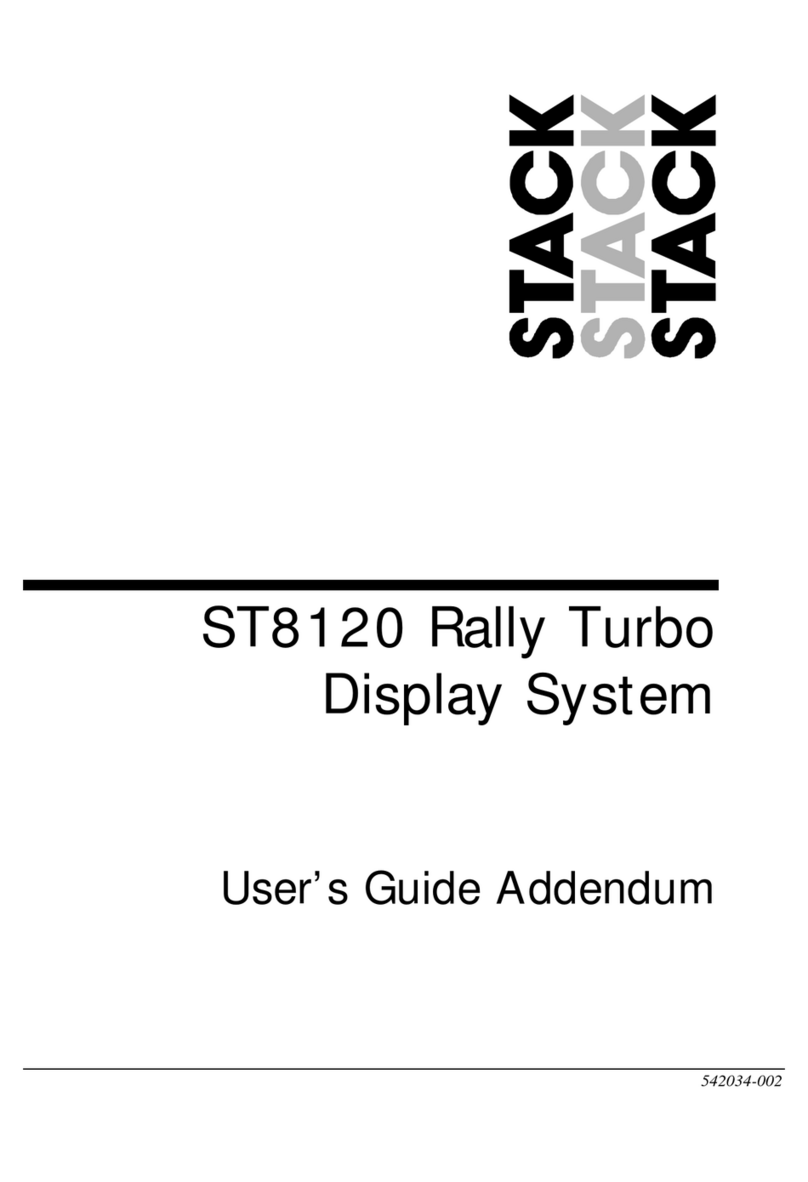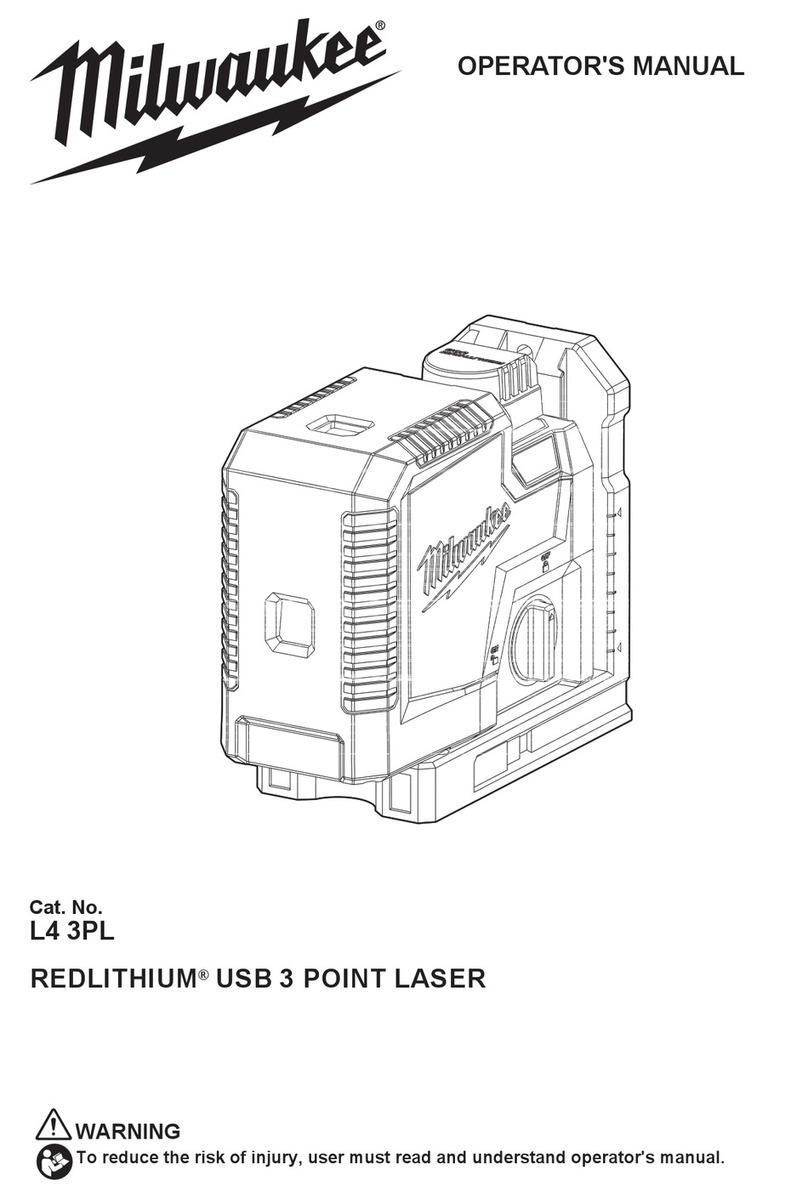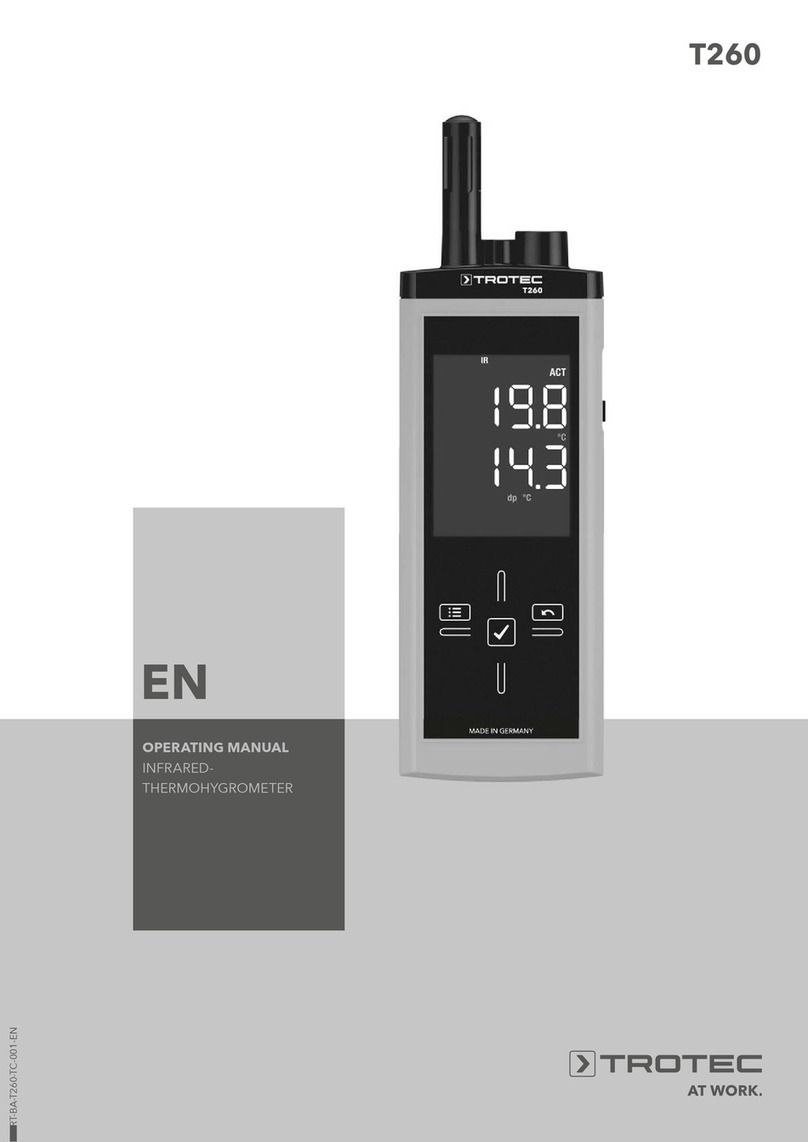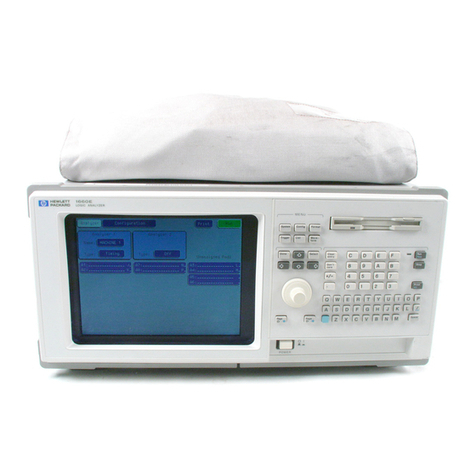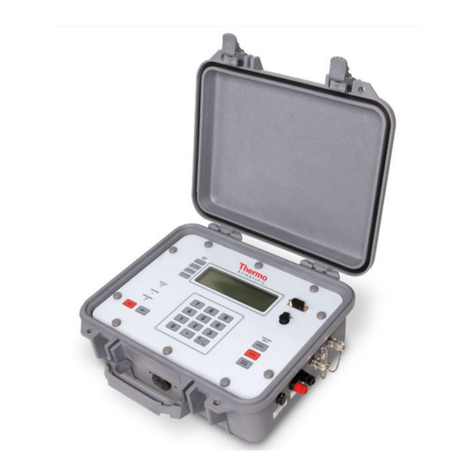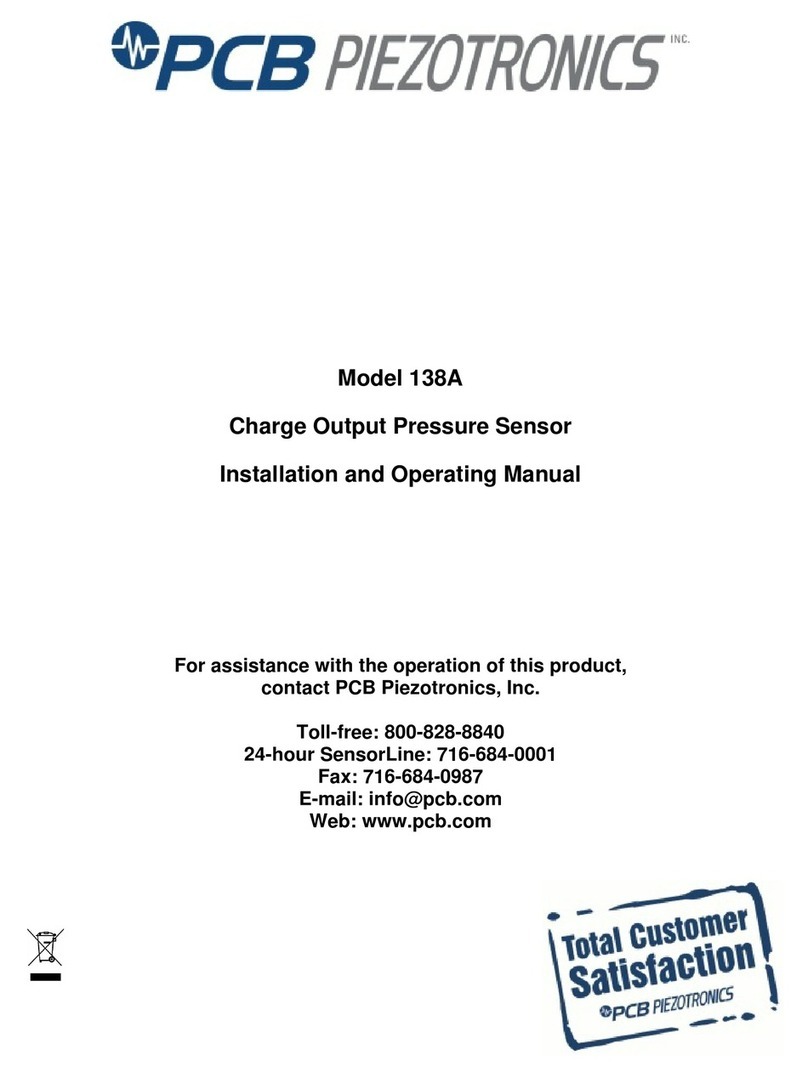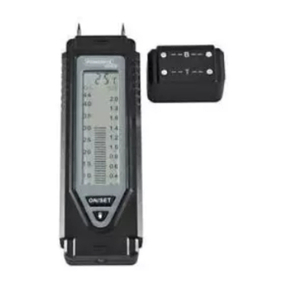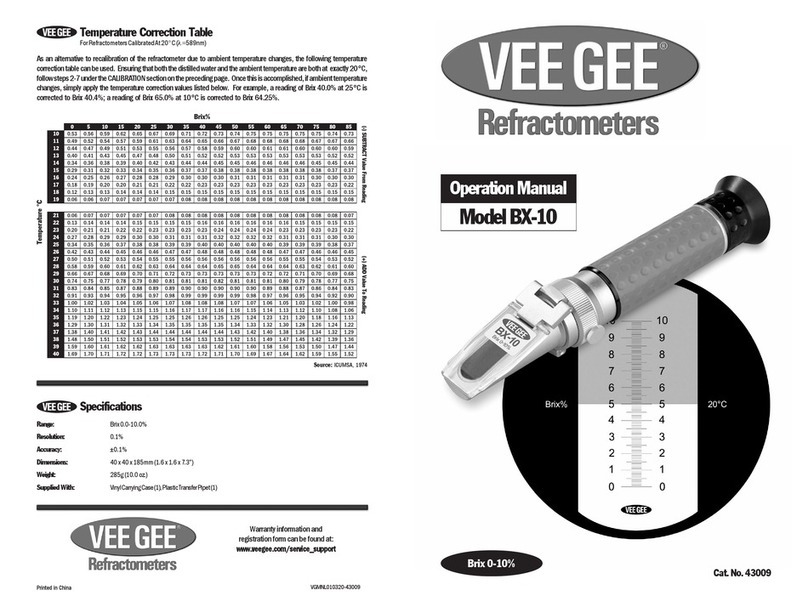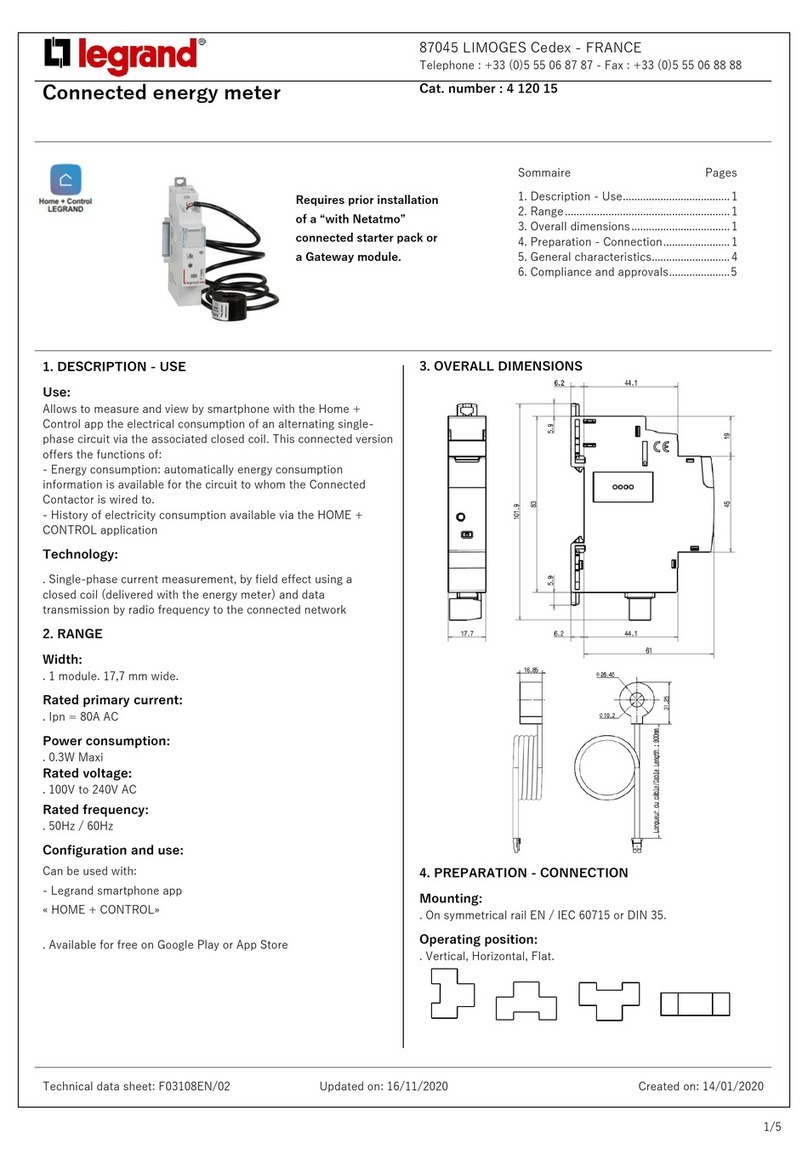TPI 265 User manual

265
Digital Clamp-on
Meter Instruction Manual
www. .com information@itm.com1.800.561.8187

A. INTRODUCTION
1. Congratulations!!
Thank you for purchasing TPI products. The 265 is easy
to use and is built to last. It is backed by a 3 year limit-
ed warranty. Please remember to complete and return
your product warranty registration card.
2. Product Description
The 265 is a hand-held, autoranging clamp-on DMM.
Extra large numerals, capacitance, frequency and data
hold are just a few of the features of the 265. An
affordable choice, the 265 offers measurements in all
basic electrical functions.
The 265 comes complete with the following accessories:
Carrying Pouch
Test Lead Set
Instruction Manual
Battery
TABLE OF CONTENTS
A. INTRODUCTION
1. Congratulations ..........................3
2. Product Description....................3
3. Declaration of Conformity ..........4
B. SAFETY CONSIDERATIONS ..............5
C. TECHNICAL DATA
1. Features and Benefits..................6
2. Product Applications ..................7
3. Specifications ........................8-10
D. MEASUREMENT TECHNIQUES
1. Controls and Functions ......11-13
2. Step by Step Procedures:....14-21
E. OTHER FEATURES ..........................22
F. APPLICATION NOTES ................23-26
G. TROUBLE SHOOTING GUIDE ..........27
H. MAINTENANCE ................................28
I. ACCESSORIES ................................29
23
www. .com information@itm.com1.800.561.8187

A. INTRODUCTION
1. Congratulations!!
Thank you for purchasing TPI products. The 265 is easy
to use and is built to last. It is backed by a 3 year limit-
ed warranty. Please remember to complete and return
your product warranty registration card.
2. Product Description
The 265 is a hand-held, autoranging clamp-on DMM.
Extra large numerals, capacitance, frequency and data
hold are just a few of the features of the 265. An
affordable choice, the 265 offers measurements in all
basic electrical functions.
The 265 comes complete with the following accessories:
Carrying Pouch
Test Lead Set
Instruction Manual
Battery
TABLE OF CONTENTS
A. INTRODUCTION
1. Congratulations ..........................3
2. Product Description....................3
3. Declaration of Conformity ..........4
B. SAFETY CONSIDERATIONS ..............5
C. TECHNICAL DATA
1. Features and Benefits..................6
2. Product Applications ..................7
3. Specifications ........................8-10
D. MEASUREMENT TECHNIQUES
1. Controls and Functions ......11-13
2. Step by Step Procedures:....14-21
E. OTHER FEATURES ..........................22
F. APPLICATION NOTES ................23-26
G. TROUBLE SHOOTING GUIDE ..........27
H. MAINTENANCE ................................28
I. ACCESSORIES ................................29
23
www. .com information@itm.com1.800.561.8187

B. SAFETY CONSIDERATIONS
WARNING: Please follow manufacturers test
procedures whenever possible. Do not attempt
to measure unknown voltages or components until a
complete understanding of the circuit is obtained.
GENERAL GUIDELINES
ALWAYS
• Test the 265 before using it to make sure it is
operating properly.
• Inspect the test leads before using to make sure there
are no breaks or shorts.
• Double check all connections before testing.
• Have someone check on you periodically if
working alone.
• Have a complete understanding of the circuit
being measured.
• Disconnect power to circuit, then connect test leads to
the 265, then to circuit being measured.
NEVER
• Attempt to measure unknown high voltages.
• Attempt to measure DC microamps with the meter in
parallel to the circuit.
• Connect the test leads to a live circuit before
setting up the instrument.
• Touch any exposed metal part of the test lead assembly.
3. EC Declaration of Conformity
This is to certify that TPI Model 265 conforms to the
protection requirements of the council directive
89/336/EEC, in the approximation of laws of the member
states relating to Electromagnetic compatibility and
73/23/EEC. The Low Voltage Directive by application of
the following standards:
EN 50081-1 1992 Emissions Standard
EN 50082-1 1992 Immunity Standard
EN 61010-1 1993 Safety Standard
EN 61010-2-031 1995 Safety Standard
EN 61010-2-032 1995 Safety Standard
To ensure conformity with these standard, this instru-
ment must be operated in accordance with the instruc-
tions and specifications given in this manual.
CAUTION: Even though this instrument complies with
the immunity standards, it’s accuracy can be affected
by strong radio emissions not covered in the above
standards. Sources such as hand-held radio trans-
ceivers, radio and TV transmitters, vehicle radios and
cellular phones generate electromagnetic radiation
that could be induced into the test leads of this instru-
ment. Care should be taken to avoid such situations or
alternatively, check to make sure that the instrument is
not being influence by these emissions.
CAUTION: Please follow manufacturers test proce-
dures whenever possible. Do not attempt to measure
unknown voltages or components until a complete
understanding of the circuit is obtained.
4 5
www. .com information@itm.com1.800.561.8187

B. SAFETY CONSIDERATIONS
WARNING: Please follow manufacturers test
procedures whenever possible. Do not attempt
to measure unknown voltages or components until a
complete understanding of the circuit is obtained.
GENERAL GUIDELINES
ALWAYS
• Test the 265 before using it to make sure it is
operating properly.
• Inspect the test leads before using to make sure there
are no breaks or shorts.
• Double check all connections before testing.
• Have someone check on you periodically if
working alone.
• Have a complete understanding of the circuit
being measured.
• Disconnect power to circuit, then connect test leads to
the 265, then to circuit being measured.
NEVER
• Attempt to measure unknown high voltages.
• Attempt to measure DC microamps with the meter in
parallel to the circuit.
• Connect the test leads to a live circuit before
setting up the instrument.
• Touch any exposed metal part of the test lead assembly.
3. EC Declaration of Conformity
This is to certify that TPI Model 265 conforms to the
protection requirements of the council directive
89/336/EEC, in the approximation of laws of the member
states relating to Electromagnetic compatibility and
73/23/EEC. The Low Voltage Directive by application of
the following standards:
EN 50081-1 1992 Emissions Standard
EN 50082-1 1992 Immunity Standard
EN 61010-1 1993 Safety Standard
EN 61010-2-031 1995 Safety Standard
EN 61010-2-032 1995 Safety Standard
To ensure conformity with these standard, this instru-
ment must be operated in accordance with the instruc-
tions and specifications given in this manual.
CAUTION: Even though this instrument complies with
the immunity standards, it’s accuracy can be affected
by strong radio emissions not covered in the above
standards. Sources such as hand-held radio trans-
ceivers, radio and TV transmitters, vehicle radios and
cellular phones generate electromagnetic radiation
that could be induced into the test leads of this instru-
ment. Care should be taken to avoid such situations or
alternatively, check to make sure that the instrument is
not being influence by these emissions.
CAUTION: Please follow manufacturers test proce-
dures whenever possible. Do not attempt to measure
unknown voltages or components until a complete
understanding of the circuit is obtained.
4 5
www. .com information@itm.com1.800.561.8187

INTERNATIONAL SYMBOLS
CAUTION: RISK OF ELECTRIC SHOCK
AC (Alternation Current)
DC (Direct Current)
REFER TO INSTRUCTION MANUAL
GROUND
DOUBLE INSULATION
EITHER DC OR AC
C. TECHNICAL DATA
1. Features and Benefits
Agency Meets CE and IEC 1010.
Auto Off Automatically powers off after 10
minutes of inactivity. When active,
APO is displayed on the LCD.
NOTE: To disable Auto Off, hold
down the RANGE button while
turning on the 265.
2. Product Applications
Perform the following tests and/or measurements with
the 265 and the appropriate function:
HVAC/R
DCmV • Thermocouples in furnaces.
ACA • Heat anticipator current in thermostats.
ACV • Line voltage.
ACV or DCV • Control circuit voltage.
OHMS • Compressor winding resistance.
OHMS • Continuity of wiring.
CAP • Motor start and run capacitors.
ACA • Motor and compressor start up current.
Hz • Frequency on controls and line voltage.
ELECTRICAL
ACV • Measure line voltage.
ACA • Measure line current.
OHMS • Continuity of circuit breakers.
DCV • Voltage of direct drive DC motors.
ACA • Start up current of motors, relays,
contactors and transformers.
ELECTRONIC
ACV • Measure power supply voltage.
ACA • Measure power supply current.
OHMS • Continuity of circuit breakers and fuses.
6 7
www. .com information@itm.com1.800.561.8187

INTERNATIONAL SYMBOLS
CAUTION: RISK OF ELECTRIC SHOCK
AC (Alternation Current)
DC (Direct Current)
REFER TO INSTRUCTION MANUAL
GROUND
DOUBLE INSULATION
EITHER DC OR AC
C. TECHNICAL DATA
1. Features and Benefits
Agency Meets CE and IEC 1010.
Auto Off Automatically powers off after 10
minutes of inactivity. When active,
APO is displayed on the LCD.
NOTE: To disable Auto Off, hold
down the RANGE button while
turning on the 265.
2. Product Applications
Perform the following tests and/or measurements with
the 265 and the appropriate function:
HVAC/R
DCmV • Thermocouples in furnaces.
ACA • Heat anticipator current in thermostats.
ACV • Line voltage.
ACV or DCV • Control circuit voltage.
OHMS • Compressor winding resistance.
OHMS • Continuity of wiring.
CAP • Motor start and run capacitors.
ACA • Motor and compressor start up current.
Hz • Frequency on controls and line voltage.
ELECTRICAL
ACV • Measure line voltage.
ACA • Measure line current.
OHMS • Continuity of circuit breakers.
DCV • Voltage of direct drive DC motors.
ACA • Start up current of motors, relays,
contactors and transformers.
ELECTRONIC
ACV • Measure power supply voltage.
ACA • Measure power supply current.
OHMS • Continuity of circuit breakers and fuses.
6 7
www. .com information@itm.com1.800.561.8187

9
3. Specifications
IEC 1010 Over Voltage:
CAT II - 1000V
CAT III - 600V
Pollution Degree 2
Temperature for gauranteed accuracy: 23ºC +5ºC
DC VOLTS
Range Res. Accuracy
400mV 0.1mV +/-(0.3% of reading + 5 digits) Impedance:
4V 0.001V 10MΩ
40V 0.01V +/-(0.5% of reading + 4 digits) Overload Protection:
400V 0.1V 600VDC or AC RMS
600V 1V +/-(1.0% of reading + 4 digits)
(40Hz to 60Hz Frequency Response 400mV Range)
AC VOLTS (40Hz to 400Hz Frequency Response All Other Ranges)
Range Res. Accuracy
400mV 0.1mV +/-(1.5% of reading + 5 digits) Impedance:
4V 0.001V 10MΩ
40V 0.01V +/-(1.5% of reading + 5 digits) Overload Protection:
400V 0.1V 600VDC or AC RMS
600V 1V
8
OHM (Resistance, Ω)
Range Res. Accuracy
400Ω0.1Ω
4kΩ0.001kΩ±(0.8% of reading +5 digits) Overload Protection:
40kΩ0.01kΩ250VDC or AC RMS
400kΩ0.1kΩ
4MΩ0.001MΩ±(2% of reading +10 digits)
40MΩ0.01MΩ
Frequency (Hz)
Range Res. Accuracy
4000Hz 1Hz
40.00kHz 0.01kHz
400.0kHz 0.1kHz ±(0.5% of reading +2 digits) Overload Protection:
4.000MHz 0.001MHz 250VDC or AC RMS
40.00MHz 0.01MHz
Diode Test
Test Current Over Load Protection
1.5mA MAX 250 V DC or AC RMS
Continuity Buzzer
Test Voltage Threshold Over Load Protection
3V <35Ω250 V DC or AC RMS
UL 3111 Pending
(45Hz to 100Hz Frequency Response 200A to 400A)
AC AMPS (45Hz to 450Hz Frequency Response Below 200A)
Range Res. Accuracy
40A 0.01A +/-(3.0% of reading + 5 digits)
400A 0.1A e
www. .com information@itm.com1.800.561.8187

9
3. Specifications
IEC 1010 Over Voltage:
CAT II - 1000V
CAT III - 600V
Pollution Degree 2
Temperature for gauranteed accuracy: 23ºC +5ºC
DC VOLTS
Range Res. Accuracy
400mV 0.1mV +/-(0.3% of reading + 5 digits) Impedance:
4V 0.001V 10MΩ
40V 0.01V +/-(0.5% of reading + 4 digits) Overload Protection:
400V 0.1V 600VDC or AC RMS
600V 1V +/-(1.0% of reading + 4 digits)
(40Hz to 60Hz Frequency Response 400mV Range)
AC VOLTS (40Hz to 400Hz Frequency Response All Other Ranges)
Range Res. Accuracy
400mV 0.1mV +/-(1.5% of reading + 5 digits) Impedance:
4V 0.001V 10MΩ
40V 0.01V +/-(1.5% of reading + 5 digits) Overload Protection:
400V 0.1V 600VDC or AC RMS
600V 1V
8
OHM (Resistance, Ω)
Range Res. Accuracy
400Ω0.1Ω
4kΩ0.001kΩ±(0.8% of reading +5 digits) Overload Protection:
40kΩ0.01kΩ250VDC or AC RMS
400kΩ0.1kΩ
4MΩ0.001MΩ±(2% of reading +10 digits)
40MΩ0.01MΩ
Frequency (Hz)
Range Res. Accuracy
4000Hz 1Hz
40.00kHz 0.01kHz
400.0kHz 0.1kHz ±(0.5% of reading +2 digits) Overload Protection:
4.000MHz 0.001MHz 250VDC or AC RMS
40.00MHz 0.01MHz
Diode Test
Test Current Over Load Protection
1.5mA MAX 250 V DC or AC RMS
Continuity Buzzer
Test Voltage Threshold Over Load Protection
3V <35Ω250 V DC or AC RMS
UL 3111 Pending
(45Hz to 100Hz Frequency Response 200A to 400A)
AC AMPS (45Hz to 450Hz Frequency Response Below 200A)
Range Res. Accuracy
40A 0.01A +/-(3.0% of reading + 5 digits)
400A 0.1A e
www. .com information@itm.com1.800.561.8187

11
10
Capacitance
Range Res. Accuracy
4nF 0.001nF
40nF 0.01nF
400nF 0.1nF Overload Protection:
4µF 0.001µF±(3% of reading +10 digits) 500VDC or AC RMS
40µF 0.01µF
400µF 0.1uF
4mF 0.001mF ±(7% of reading +10 digits)
nF= nanofarad, µF= microfarad, mF= millifarad
General
Max Voltage between any 600V
input and ground
Fuse Protection (µµA range) 0.5A/600V
Display Type 4000 Count 41 seg. bargraph
Operating Temperature 32ºF to 113ºF (0ºC to 40ºC)
Storage Temperature -4ºF to 140ºF (-20ºC to 60ºC)
Relative Humidity 80% non-condensing
Power Supply 9V (MN1604)
Battery Life 80 hrs. typical
Size (H x L x W) 32.5mm x 255mm x 65mm
(1.3in x 10in x 2.5in)
Weight 363g (0.8lbs)
Jaws for Measuring
AC Amps Only
RANGE
Push Button HOLD Push
Button
Rotary
Switch
LCD Display
with Function
Annunciators
Input Jacks
Trigger for
Opening
the Jaws
D. MEASUREMENT TECHNIQUES
1. Controls and Functions:
www. .com information@itm.com1.800.561.8187

11
10
Capacitance
Range Res. Accuracy
4nF 0.001nF
40nF 0.01nF
400nF 0.1nF Overload Protection:
4µF 0.001µF±(3% of reading +10 digits) 500VDC or AC RMS
40µF 0.01µF
400µF 0.1uF
4mF 0.001mF ±(7% of reading +10 digits)
nF= nanofarad, µF= microfarad, mF= millifarad
General
Max Voltage between any 600V
input and ground
Fuse Protection (µµA range) 0.5A/600V
Display Type 4000 Count 41 seg. bargraph
Operating Temperature 32ºF to 113ºF (0ºC to 40ºC)
Storage Temperature -4ºF to 140ºF (-20ºC to 60ºC)
Relative Humidity 80% non-condensing
Power Supply 9V (MN1604)
Battery Life 80 hrs. typical
Size (H x L x W) 32.5mm x 255mm x 65mm
(1.3in x 10in x 2.5in)
Weight 363g (0.8lbs)
Jaws for Measuring
AC Amps Only
RANGE
Push Button HOLD Push
Button
Rotary
Switch
LCD Display
with Function
Annunciators
Input Jacks
Trigger for
Opening
the Jaws
D. MEASUREMENT TECHNIQUES
1. Controls and Functions:
www. .com information@itm.com1.800.561.8187

13
12
Controls and Functions: (cont.)
Input Jacks
COM Black test lead connection for all
measurements except AC Amps.
V/ΩΩ/ /Hz Red test lead connection for all
measurements except AC Amps.
Controls and Functions: (cont.)
Push Buttons
HOLD Holds the reading on the display
until the button is pushed a
second time.
RANGE Activates manual ranging. Press and
hold for 2 seconds to return to auto
ranging.
Rotary Switch
OFF Turns the 265 completely off.
VUsed to measure DC volts.
VUsed to measure AC volts.
ΩΩUsed to measure resistance.
Used to measure continuity.
Selects diode test function.
Selects capacitance test function.
Hz Selects frequency test function.
Used to measure AC amperage.
www. .com information@itm.com1.800.561.8187

13
12
Controls and Functions: (cont.)
Input Jacks
COM Black test lead connection for all
measurements except AC Amps.
V/ΩΩ/ /Hz Red test lead connection for all
measurements except AC Amps.
Controls and Functions: (cont.)
Push Buttons
HOLD Holds the reading on the display
until the button is pushed a
second time.
RANGE Activates manual ranging. Press and
hold for 2 seconds to return to auto
ranging.
Rotary Switch
OFF Turns the 265 completely off.
VUsed to measure DC volts.
VUsed to measure AC volts.
ΩΩUsed to measure resistance.
Used to measure continuity.
Selects diode test function.
Selects capacitance test function.
Hz Selects frequency test function.
Used to measure AC amperage.
www. .com information@itm.com1.800.561.8187

14
Measuring AC Voltage
WARNING!
Do not attempt to make a voltage measurement of more than
600V or of a voltage level that is unknown. Make sure the tem-
perature probe is NOT plugged in during this test.
Instrument set-up:
FUNC. BLACK RED MIN MAX
TEST LEAD TEST LEAD READING READING
COM V/Ω0.1mV 600V
Measurement Procedure:
1. Disconnect power to circuit to be measured.
2. Plug black test lead into the COM input jack.
3 Plug red test lead into the V/Ωinput jack.
4. Set rotary switch to the V range.
5. Connect test leads to circuit to be measured.
6. Reconnect power to circuit to be measured.
7. Read the voltage on the 265.
Optional Modes
•HOLD: Freezes the reading on the LCD.
•RANGE: Activates manual ranging. Press and hold for
2 seconds to return to auto ranging.
15
2. Step by Step Procedures:
Measuring DC Voltage
WARNING!
Do not attempt to make a voltage measurement of more
than 600V or of a voltage level that is unknown. Make sure
the temperature probe is NOT plugged in during this test.
Instrument set-up:
FUNC. BLACK RED MIN MAXI
TEST LEAD TEST LEAD READING READING
COM V/Ω0.1mV 600V
Measurement Procedure:
1. Disconnect power to circuit to be measured.
2. Plug black test lead into the COM input jack.
3 Plug red test lead into the V/Ωinput jack.
4. Set rotary switch to the V range.
5. Connect test leads to circuit to be measured.
6. Reconnect power to circuit to be measured.
7. Read the voltage on the 265.
Optional Modes
•HOLD: Freezes the reading on the LCD.
•RANGE: Activates manual ranging. Press and hold for
2 seconds to return to auto ranging.
www. .com information@itm.com1.800.561.8187

14
Measuring AC Voltage
WARNING!
Do not attempt to make a voltage measurement of more than
600V or of a voltage level that is unknown. Make sure the tem-
perature probe is NOT plugged in during this test.
Instrument set-up:
FUNC. BLACK RED MIN MAX
TEST LEAD TEST LEAD READING READING
COM V/Ω0.1mV 600V
Measurement Procedure:
1. Disconnect power to circuit to be measured.
2. Plug black test lead into the COM input jack.
3 Plug red test lead into the V/Ωinput jack.
4. Set rotary switch to the V range.
5. Connect test leads to circuit to be measured.
6. Reconnect power to circuit to be measured.
7. Read the voltage on the 265.
Optional Modes
•HOLD: Freezes the reading on the LCD.
•RANGE: Activates manual ranging. Press and hold for
2 seconds to return to auto ranging.
15
2. Step by Step Procedures:
Measuring DC Voltage
WARNING!
Do not attempt to make a voltage measurement of more
than 600V or of a voltage level that is unknown. Make sure
the temperature probe is NOT plugged in during this test.
Instrument set-up:
FUNC. BLACK RED MIN MAXI
TEST LEAD TEST LEAD READING READING
COM V/Ω0.1mV 600V
Measurement Procedure:
1. Disconnect power to circuit to be measured.
2. Plug black test lead into the COM input jack.
3 Plug red test lead into the V/Ωinput jack.
4. Set rotary switch to the V range.
5. Connect test leads to circuit to be measured.
6. Reconnect power to circuit to be measured.
7. Read the voltage on the 265.
Optional Modes
•HOLD: Freezes the reading on the LCD.
•RANGE: Activates manual ranging. Press and hold for
2 seconds to return to auto ranging.
www. .com information@itm.com1.800.561.8187

17
16
Measuring AC Amperage
CAUTION!
Do not attempt to make a current measurement with the
test leads. The 265 measures the current by clamping the
jaw around one conductor (wire). Clamping around more
than one wire will result in erroneous readings. Make sure
the temperature probe is NOT plugged in during this test.
Instrument set-up:
FUNC. BLACK RED MIN MAX
TEST LEAD TEST LEAD READING READING
NOT USED NOT USED 0.01A 400A
Measurement Procedure:
1. Disconnect power to circuit to be measured.
2. Set rotary switch to function.
3. Clamp the jaws around one conductor of the circuit to
be measured. For best results, center the wire in the
jaw.
4. Reconnect power to circuit to be measured.
5. Read the current on the 265.
Optional Modes
•HOLD: Freezes the reading on the LCD.
•RANGE: Activates manual ranging. Press and hold for
2 seconds to return to auto ranging.
Measuring Resistance
WARNING!
Do not attempt to make resistance measurements with circuit
energized. For best results, remove the resistor completely from
circuit before attempting to measure it. Make sure the tempera-
ture probe is NOT plugged in during this test.
NOTE:
To make accurate low ohm measurements, short the ends of the
test leads together and press the REL button to store the reading.
This will deduct the stored value from subsequent measurements
eliminating the test lead resistance from the reading.
Instrument set-up:
FUNC. BLACK RED MIN MAX
TEST LEAD TEST LEAD READING READING
ΩCOM V/Ω0.1Ω40.00MΩ
Measurement Procedure:
1. Disconnect power to circuit to be measured.
2. Plug black test lead into the COM input jack.
3. Plug red test lead into V/Ωinput jack.
4. Set the rotary switch to the Ωfunction.
5. Connect test leads to circuit to be measured.
6. Read the resistance value on the 265.
Optional Modes
•HOLD: Freezes the reading on the LCD.
•RANGE: Activates manual ranging. Press and hold for
2 seconds to return to auto ranging.
www. .com information@itm.com1.800.561.8187

17
16
Measuring AC Amperage
CAUTION!
Do not attempt to make a current measurement with the
test leads. The 265 measures the current by clamping the
jaw around one conductor (wire). Clamping around more
than one wire will result in erroneous readings. Make sure
the temperature probe is NOT plugged in during this test.
Instrument set-up:
FUNC. BLACK RED MIN MAX
TEST LEAD TEST LEAD READING READING
NOT USED NOT USED 0.01A 400A
Measurement Procedure:
1. Disconnect power to circuit to be measured.
2. Set rotary switch to function.
3. Clamp the jaws around one conductor of the circuit to
be measured. For best results, center the wire in the
jaw.
4. Reconnect power to circuit to be measured.
5. Read the current on the 265.
Optional Modes
•HOLD: Freezes the reading on the LCD.
•RANGE: Activates manual ranging. Press and hold for
2 seconds to return to auto ranging.
Measuring Resistance
WARNING!
Do not attempt to make resistance measurements with circuit
energized. For best results, remove the resistor completely from
circuit before attempting to measure it. Make sure the tempera-
ture probe is NOT plugged in during this test.
NOTE:
To make accurate low ohm measurements, short the ends of the
test leads together and press the REL button to store the reading.
This will deduct the stored value from subsequent measurements
eliminating the test lead resistance from the reading.
Instrument set-up:
FUNC. BLACK RED MIN MAX
TEST LEAD TEST LEAD READING READING
ΩCOM V/Ω0.1Ω40.00MΩ
Measurement Procedure:
1. Disconnect power to circuit to be measured.
2. Plug black test lead into the COM input jack.
3. Plug red test lead into V/Ωinput jack.
4. Set the rotary switch to the Ωfunction.
5. Connect test leads to circuit to be measured.
6. Read the resistance value on the 265.
Optional Modes
•HOLD: Freezes the reading on the LCD.
•RANGE: Activates manual ranging. Press and hold for
2 seconds to return to auto ranging.
www. .com information@itm.com1.800.561.8187

18
Measuring Diodes
WARNING!
Do not attempt to make diode measurements with the circuit
energized. For accurate tests, remove the diode completely
from the circuit prior to measuring it. Make sure the tempera-
ture probe is NOT plugged in during this test.
Instrument set-up:
FUNC. BLACK RED
TEST LEAD TEST LEAD
COM V/Ω/µA
Measurement Procedure:
1. Disconnect power to circuit to be measured.
2. Plug black test lead into the COM input jack.
3. Plug red test lead into V/Ω
input jack.
4. Set the rotary switch to the
5. Connect the black test lead to the banded end of the diode
(cathode) and the red test lead to the non-banded end of
the diode (anode).
6. For a good diode, the reading on the display should be
between 0.5V and 0.8V. The reading will be lower for a
germanium diode.
7. Reverse the leads on the diode.
8. For a good diode, the reading on the display should be OL
(overload).
Optional Modes
•HOLD: Freezes the reading on the LCD. 19
position.
Measuring Continuity
WARNING!
Do not attempt to make continuity measurements with circuit
energized. Make sure the temperature probe is NOT plugged
in during this test.
Instrument set-up:
FUNC. BLACK RED
TEST LEAD TEST LEAD
COM V/Ω
Measurement Procedure:
1. Disconnect power to circuit to be measured.
2. Plug black test lead into the COM input jack.
3. Plug red test lead into V/Ωinput jack.
4. Set the rotary switch to the position.
5. Connect test leads to circuit to be measured.
6. The 265 will beep and the LED will illuminate at
resistances of 35Ωor lower.
Optional Modes
•HOLD: Freezes the reading on the LCD.
www. .com information@itm.com1.800.561.8187

18
Measuring Diodes
WARNING!
Do not attempt to make diode measurements with the circuit
energized. For accurate tests, remove the diode completely
from the circuit prior to measuring it. Make sure the tempera-
ture probe is NOT plugged in during this test.
Instrument set-up:
FUNC. BLACK RED
TEST LEAD TEST LEAD
COM V/Ω/µA
Measurement Procedure:
1. Disconnect power to circuit to be measured.
2. Plug black test lead into the COM input jack.
3. Plug red test lead into V/Ω
input jack.
4. Set the rotary switch to the
5. Connect the black test lead to the banded end of the diode
(cathode) and the red test lead to the non-banded end of
the diode (anode).
6. For a good diode, the reading on the display should be
between 0.5V and 0.8V. The reading will be lower for a
germanium diode.
7. Reverse the leads on the diode.
8. For a good diode, the reading on the display should be OL
(overload).
Optional Modes
•HOLD: Freezes the reading on the LCD. 19
position.
Measuring Continuity
WARNING!
Do not attempt to make continuity measurements with circuit
energized. Make sure the temperature probe is NOT plugged
in during this test.
Instrument set-up:
FUNC. BLACK RED
TEST LEAD TEST LEAD
COM V/Ω
Measurement Procedure:
1. Disconnect power to circuit to be measured.
2. Plug black test lead into the COM input jack.
3. Plug red test lead into V/Ωinput jack.
4. Set the rotary switch to the position.
5. Connect test leads to circuit to be measured.
6. The 265 will beep and the LED will illuminate at
resistances of 35Ωor lower.
Optional Modes
•HOLD: Freezes the reading on the LCD.
www. .com information@itm.com1.800.561.8187

21
20
Measuring Frequency
WARNING!
Never attempt a frequency measurement with a voltage source
greater than 500V. Determine the voltage of any unknown fre-
quency source before connecting the instrument in frequency
mode. Make sure the temperature probe is NOT plugged in
during this test.
Instrument set-up:
FUNC. BLACK RED
TEST LEAD TEST LEAD
Hz COM V/Ω/µA
Measurement Procedure:
1. Disconnect power to the circuit to be measured.
2. Plug black test lead into the COM input jack.
3. Plug red test lead into V/Ωinput jack.
4. Set the rotary switch to the Hz position.
5. Reconnect power to the circuit to be measured.
6. Read the frequency on the LCD.
Optional Modes
•HOLD: Freezes the reading on the LCD.
•RANGE: Activates manual ranging. Press and hold for
2 seconds to return to auto ranging.
Measuring Capacitance
WARNING!
All capacitance measurements are to be made on de-energized
circuits with all capacitors discharged only. Failure to de-energize
and discharge capacitors prior to measuring them could result in
instrument damage and/or personal injury. Make sure the temper-
ature probe is NOT plugged in during this test.
Instrument set-up:
FUNC. BLACK RED
TEST LEAD TEST LEAD
COM V/Ω/µA
Measurement Procedure:
1. Disconnect power to circuit to be measured.
2. Plug black test lead into the COM input jack.
3. Plug red test lead into V/Ω
input jack.
4. Set the rotary switch to the
5. Remove the capacitor from the circuit and discharge it.
6. Connect test leads to the capacitor to be measured.
Observe polarity on polarity sensitive capacitors.
7. Read the capacitor value on the LCD.
Optional Modes
•HOLD: Freezes the reading on the LCD.
•RANGE: Activates manual ranging. Press and hold for
2 seconds to return to auto ranging.
position.
www. .com information@itm.com1.800.561.8187
Table of contents
Other TPI Measuring Instrument manuals
